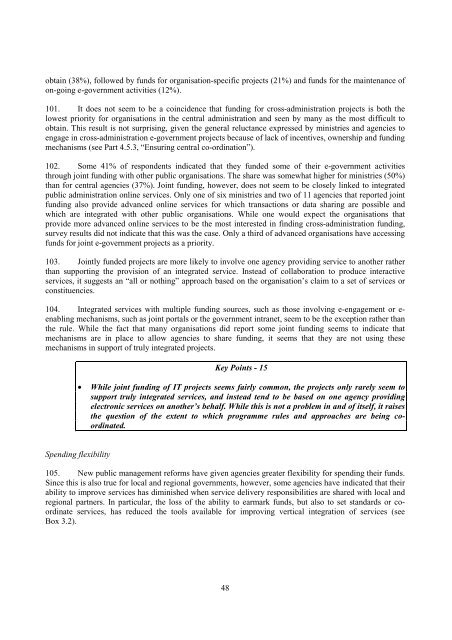e-GOVERNMENT IN FINLAND - ePractice.eu
e-GOVERNMENT IN FINLAND - ePractice.eu
e-GOVERNMENT IN FINLAND - ePractice.eu
Create successful ePaper yourself
Turn your PDF publications into a flip-book with our unique Google optimized e-Paper software.
obtain (38%), followed by funds for organisation-specific projects (21%) and funds for the maintenance of<br />
on-going e-government activities (12%).<br />
101. It does not seem to be a coincidence that funding for cross-administration projects is both the<br />
lowest priority for organisations in the central administration and seen by many as the most difficult to<br />
obtain. This result is not surprising, given the general reluctance expressed by ministries and agencies to<br />
engage in cross-administration e-government projects because of lack of incentives, ownership and funding<br />
mechanisms (see Part 4.5.3, “Ensuring central co-ordination”).<br />
102. Some 41% of respondents indicated that they funded some of their e-government activities<br />
through joint funding with other public organisations. The share was somewhat higher for ministries (50%)<br />
than for central agencies (37%). Joint funding, however, does not seem to be closely linked to integrated<br />
public administration online services. Only one of six ministries and two of 11 agencies that reported joint<br />
funding also provide advanced online services for which transactions or data sharing are possible and<br />
which are integrated with other public organisations. While one would expect the organisations that<br />
provide more advanced online services to be the most interested in finding cross-administration funding,<br />
survey results did not indicate that this was the case. Only a third of advanced organisations have accessing<br />
funds for joint e-government projects as a priority.<br />
103. Jointly funded projects are more likely to involve one agency providing service to another rather<br />
than supporting the provision of an integrated service. Instead of collaboration to produce interactive<br />
services, it suggests an “all or nothing” approach based on the organisation’s claim to a set of services or<br />
constituencies.<br />
104. Integrated services with multiple funding sources, such as those involving e-engagement or eenabling<br />
mechanisms, such as joint portals or the government intranet, seem to be the exception rather than<br />
the rule. While the fact that many organisations did report some joint funding seems to indicate that<br />
mechanisms are in place to allow agencies to share funding, it seems that they are not using these<br />
mechanisms in support of truly integrated projects.<br />
Key Points - 15<br />
x While joint funding of IT projects seems fairly common, the projects only rarely seem to<br />
support truly integrated services, and instead tend to be based on one agency providing<br />
electronic services on another’s behalf. While this is not a problem in and of itself, it raises<br />
the question of the extent to which programme rules and approaches are being coordinated.<br />
Spending flexibility<br />
105. New public management reforms have given agencies greater flexibility for spending their funds.<br />
Since this is also true for local and regional governments, however, some agencies have indicated that their<br />
ability to improve services has diminished when service delivery responsibilities are shared with local and<br />
regional partners. In particular, the loss of the ability to earmark funds, but also to set standards or coordinate<br />
services, has reduced the tools available for improving vertical integration of services (see<br />
Box 3.2).<br />
48
















